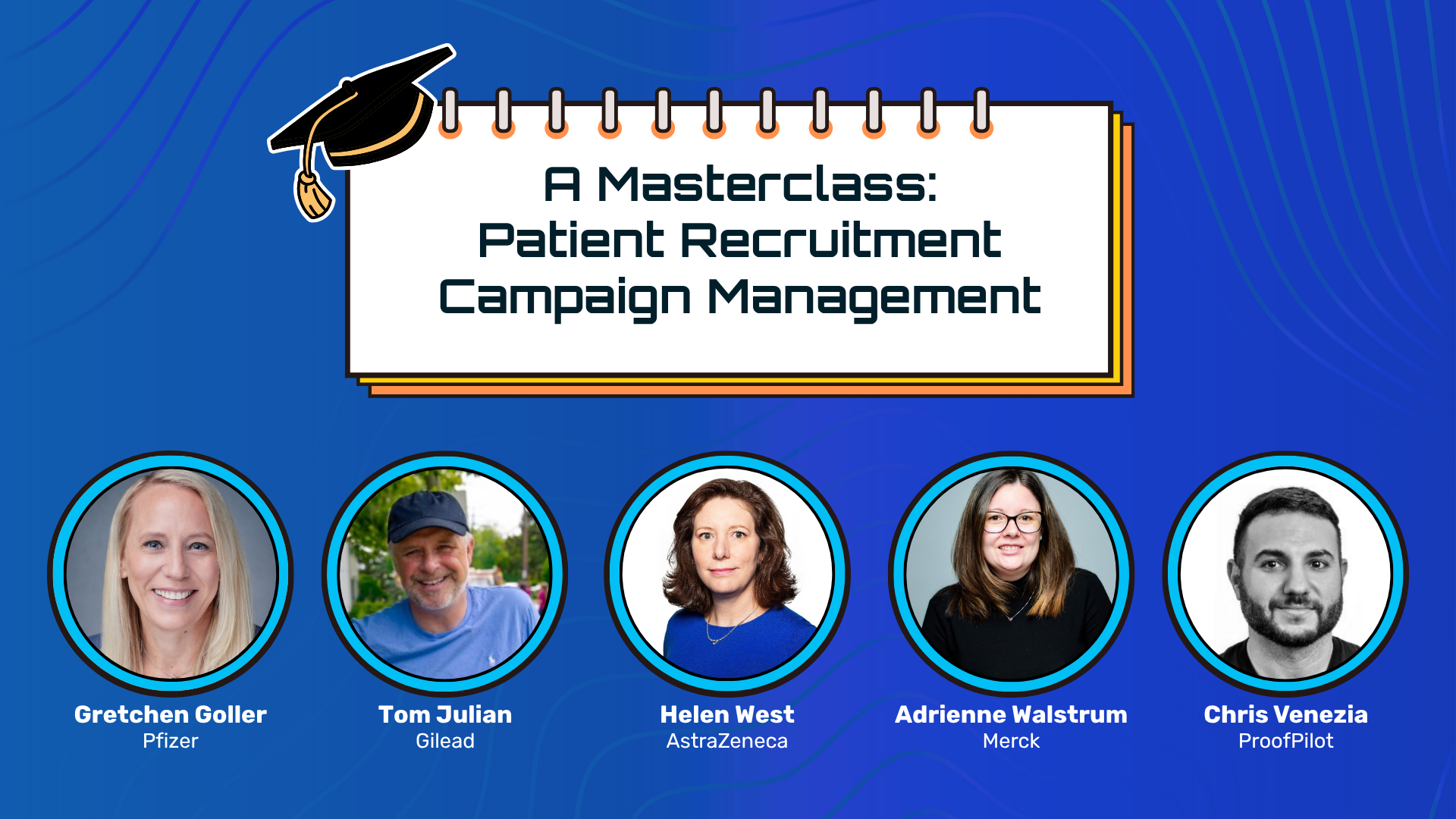The clinical trials industry is continuously abuzz with talk about the challenges of patient recruitment. And for every challenge, there is a solution. That’s great news...right?
Well, the short answer is yes: a solution to any single challenge in clinical trial execution is a wonderful thing. (Calling Captain Obvious!) But what about a more holistic conversation focused on a well-rounded strategy and must-have capabilities that support the entire recruitment funnel?
At DIA this year, we assembled a panel of expert leaders from Pfizer, Gilead, AstraZeneca, and Merck to examine real-world enrollment case studies and share tactical advice and strategies to build a successful top-to-bottom recruitment campaign.
.png?width=880&height=550&name=DIA%20Panel%20(2).png) Our fantastic panelists, left to right: Helen West, Tom Julian, Gretchen Goller, Adrienne Walstrum, and our facilitator, Chris Venezia
Our fantastic panelists, left to right: Helen West, Tom Julian, Gretchen Goller, Adrienne Walstrum, and our facilitator, Chris Venezia
Here’s what they taught the audience.
“The funnel is not a straight line”
The recruitment funnel, like traditional sales and marketing funnels, has a top, middle, and bottom, starting with trial awareness and ending with successful enrollment.
While it’s important to understand what’s happening at each stage, it’s easy to forget potential participants don’t always travel a linear path within the funnel. They may enter, back up, move around, circle it, and even re-enter through another channel or touchpoint. Keeping this in mind when looking at the data will help to uncover valuable insights about an individual trial’s unique recruitment journey.
As our CEO, Chris Venezia, put it: “How do you ensure you get the right people at the right time with the right interest level and the right criteria?” It’s a big lift—but it can be done, especially with technology designed to uncover patient attrition at every stage.
Who’s accountable? (Or rather, who isn’t?)
When the panel was asked who’s accountable for three key components of the campaign—the creation, the technology, and site responsiveness—Helen West confidently responded, “We are accountable.”
Gretchen, Adrienne, and Tom concurred, but they also agreed that part of that accountability is to engage all stakeholders, including sites and patients, and consider their needs. While sites are accountable for converting referrals, it’s crucial that sponsors establish a true collaboration. What works in the eye of the sponsor isn’t always possible at the site level.
Some detective work required
In both case studies reviewed by the panel, the most noticeable hurdle was patient drop-off at various stages throughout the recruitment funnel. The data will show where this drop-off occurs, but understanding why requires a deeper analysis.
The panel believes that some questions could help drill down to the root of the problem, based on where patients most frequently drop off:
Landing page
- Is the messaging vague?
- Is the page engaging?
- Is the information clear?
- Are there any technical errors?
- Is the call to action clear enough?
💡 Did you know? ProofPilot makes it easy to create engaging, user-friendly study landing pages
Pre-screener
- Is the completion rate low?
- Do patients drop off at a certain question?
- Are patients disappearing at a secondary screening, such as a call center?
- Is it too complex or time-consuming?
💡 Did you know? Our intelligent pre-screener includes automatic theming, advanced branching logic, and geolocation capabilities
Site locator
- Are there no sites in the vicinity?
- Is there a reason patients don’t want to go to the available centers?
And sometimes it’s even less straight forward than this. If patient drop-off is highest during the pre-screener, for instance, one might assume the issue is with the pre-screener itself. But what if, instead, it’s a disconnect between the messaging on the landing page, and questions being asked in the pre-screener? Drop-off during one stage may be indicative of a problem in a different part of the funnel.
Our sponsor panelists also suggested gathering feedback from the sites to gain a deeper understanding of the reasons for patient drop-off during recruitment.
Is it a recruitment issue? Or an operational complexity issue?
If patients aren’t converting, is it purely a recruitment issue?
Nope, not always, according to the panel. When a complex and disorganized study becomes too costly for the site to manage, guess what becomes deprioritized for a simpler study that’s easy to execute?
It’s worth the investment to minimize study complexity--not only from a study prioritization standpoint, but also because when sites spend less time on manual tasks, information scavenger hunts, and chasing down answers to questions, they can dedicate more time to potential participants in the last mile of recruitment.
It all comes down to the last mile
You can drive all the traffic in the world and get the best referrals, but if we’re not getting patients to the first visit, it’s all for naught.
Sponsors have a duty to ensure sites have the support, technology, and resources to get patients through the last mile. After all, as Gretchen stated, “I started my career at a site, and the last mile was extremely important. Unless I saw a patient personally, we had no valuable data.”
Automatic call scheduling, site/sponsor chat, and clearly organized content all contribute to higher enrollment success.
💡 See what insights Gilead Sciences and Epic Medical Research had to share about making a smoother ride on the last mile of recruitment
We get it...and we’re here to help
Whether it’s a recruitment issue or a complexity issue (or both!), we’ve got help on the way. Learn more about our platform and contact us for a deeper chat about the recruitment challenges we can overcome together.




